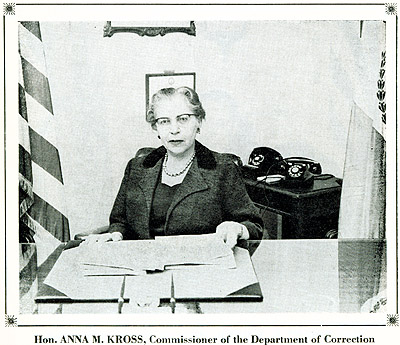
 |  |
|
ON THE BASIS of what we had learned through the testimony given during the correctional trials of 1954, our written appraisal included a statement of goals for the years ahead.
Our goals even then were far-reaching and comprehensive. Fulfillment of many of them still lies in the future, though a solid foundation has been laid for all of them in the past twelve years.
Fundamental to the development of any truly effective correctional treatment is the realization that Correction itself is an integral part of the administration of justice. For too many prisoners it has become almost the reverse: the administration of injustice, the end of the line -- a futile revolving- door type of operation which brings them back to institutional life over and over again, because a false sense of values and a fallacious economic reckoning have denied them a truly correctional experience.
Particularly is this true in the case of the many innocent persons who are still held in detention pending trial only because they are too poor to furnish bail. We are pleased, however, to be able to report that our long campaign to alleviate this bail situation is at long last beginning to bear fruit. The proper administration of justice is the fundamental responsibility of our courts.
Law, order and outward decency — a dictum enunciated by former Mayor William J. Gaynor, who had previously served as a Judge — is as sound a principle today as it was when these sentient words were first spoken.
The corollary is clear: to keep our overcrowded institutions of correction filled far beyond capacity with those who cannot be corrected through imprisonment, or with those whose only sin is poverty, is not only costly and nonsensical, it is downright immoral. Above all, it defeats the very crux of justice, since justice delayed is justice denied.
We feel hopeful that there is a growing body of thinking citizens among whom the belief in the efficacy of punishment per se is on the wane. To these thoughtful persons we commend study of our pilot projects and our evaluative researches, which we hope have laid the groundwork for the true professionalization of Correction.
Our efforts to differentiate, to draw the lines of distinction between the criminal and the sick, have already been productive of some results worth noting.
From the very beginning of this Administration, we have protested against the traditional imprisonment of addicts, whether narcotics or alcoholics.
As a result of our strenuous efforts, the Department of Correction is no longer a repository for self-committed drug addicts who are not charged with any crime; jurisdiction over them has properly been assumed by the Department of Hospitals.
And legislation designed to treat the alcoholic as a sick person rather than as a criminal has been enacted and signed into law this year.
It will take longer, but we hope that not too much time must pass, before equal recognition is accorded to the fact that there are various other classifications of prisoners who do not belong in prison, but who should instead be treated in a therapeutic facility such as a hospital or an out-patient clinic.
This category includes the mentally ill, the minor misdemeanants, the social and sex deviates (including prostitutes and homosexuals), the homeless, various types of alcoholics and narcotics addicts not already otherwise treated, the mentally retarded, the senile, and all the unfortunates who cannot quite manage to steer clear of the law.
Far too many of them still fill our prisons to overflowing without any benefit either to themselves or to the community.
STUDIES CONDUCTED BY THIS ADMINISTRATION confirm the findings of previous investigations undertaken by your Commissioner during twenty years of service on the Bench in the Criminal Courts.
We have noted that most of the individuals sentenced to correctional institutions are not criminals at all, by any informed standard.
They range from those whose problems stem from physical
[In printed book, the text continues on Page 19.]
<<=== Previous
|